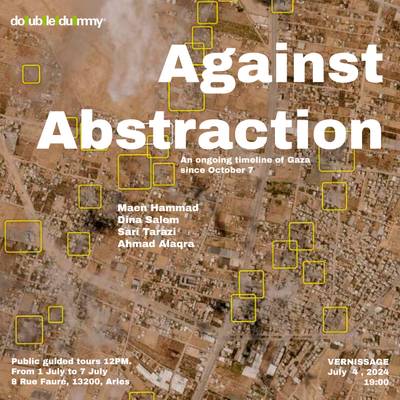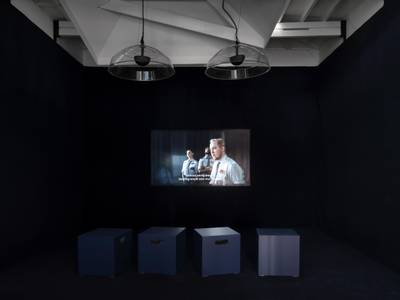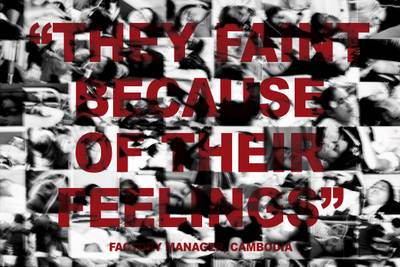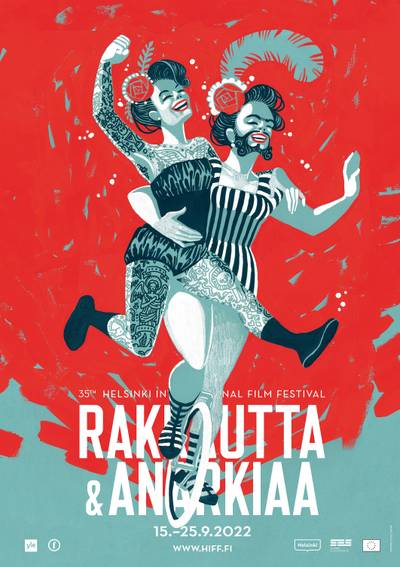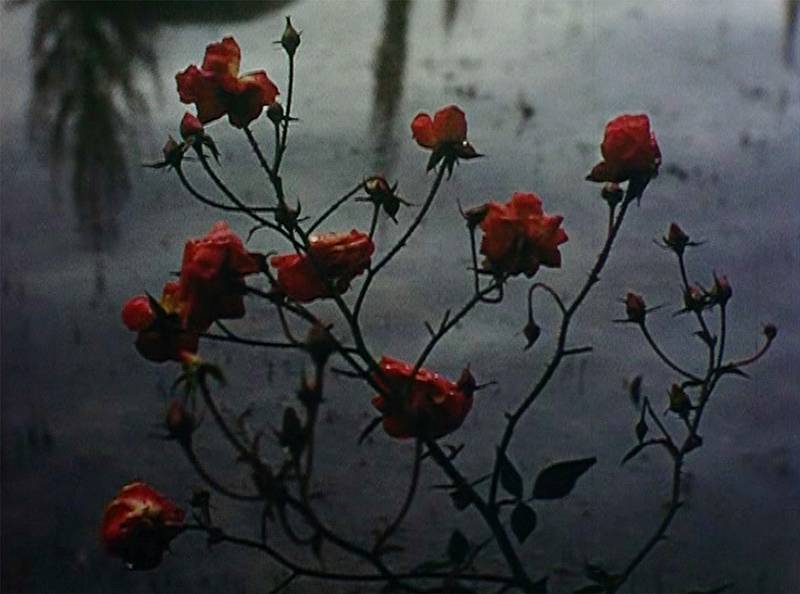

Film still from Alaa Mansour’s Aïnata, 2018
Shams Hanieh is a Palestinian-Algerian writer and researcher. Her writing and research interests include sexual health in Palestine, Arabic hip-hop and visual art, and alternative geographies. Her creative writing encompasses poetry and experimental prose exploring the surreality of Palestinian and womanhood.
There’s a line in Alaa Mansour’s Aïnata that has stayed lodged in my mind. A male narrator recounts the town’s liberation from Israeli occupation in 2000, remembering how his mother reacted. She expressed her gratitude to those who freed her Southern Lebanese village, saying they had given her access to the heavens, they showed her “the infinite magnitude of space”. This is the dream of liberation; not just having unfettered access to space, but reclaiming your perception of space itself. To feel your environment has no borders, no fixedness, no fear, only a sense of vastness and an expansion of both geography and psyche. Aïnata treats memory in a similar vein: expansive, nonlinear, and without a fixed representation or mechanism of remembering.
Aïnata (2018), shot in South Lebanon, is the debut documentary by the Lebanese research-based artist and filmmaker, Alaa Mansour. The memories being reconstituted in the film are those of Aïnata, a town in South Lebanon nestled within olive and tobacco farms, plagued for decades by Israeli occupation and violence. Mansour’s film came out in 2018, predating the current war on Lebanon and the ongoing genocide in Gaza. It focuses on Israel’s earlier cycles of colonial violence: the Israeli occupation from the 1980s until liberation in May 2000, as well as the devastation of the 2006 war. That summer alone witnessed 35 martyrs in Aïnata, killed by Zionist airstrikes. Nearly two decades later, in 2024 and 2025, Aïnata was again attacked by Israeli air raids, with several town residents martyred. History even cruelly repeated itself: in 2006, Israeli forces bombed the main cemetery of Aïnata, and in 2024 they bombed and destroyed the “July 2006” martyrs’ cemetery.
Aïnata is thus a town marked by grief, memories of violence and loss inscribed into the land itself and the bodies of its residents. Mansour’s film functions as a fragmented collage of this mourning, a mosaic of remembrance and attempts at reconstruction. The structure of the film resists categorisation, mirroring the fractured place it aims to capture. It is somewhere between an archival documentary and an impressionist elegy. Videos of women holding up images of martyrs and shouting prayers are tempered by footage of an old man picking figs, wearing what appears to be a pillowcase on his head.
We see old blurred images, archival footage of martyrs’ funeral processions, and interviews with elderly residents recalling their disparate memories of their village. Memory, here, has an “infinite magnitude”, a seemingly endless reconstitution of political and personal histories, a fragmented and fluid act of remembering. This array of images and videos is anchored by two narrative voices. One, a male voice, recalls memories of Aïnata, along with political, historical, and ideological reflections. The other voice is Mansour’s, weaving in poetic and lyrical interludes, reflecting on anything from the nature of the political image to what love means in Aïnata, and offering a reflexive view on footage of the film. The man’s voice offers an intellectual and historical backing to the often abstract film, while Mansour complements it with a poetic sentiment.
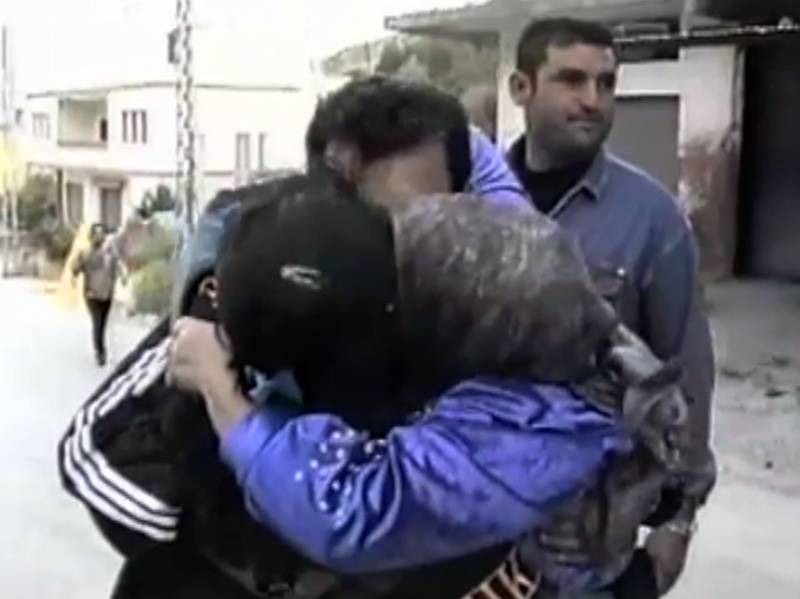

Film still from Alaa Mansour’s Aïnata, 2018
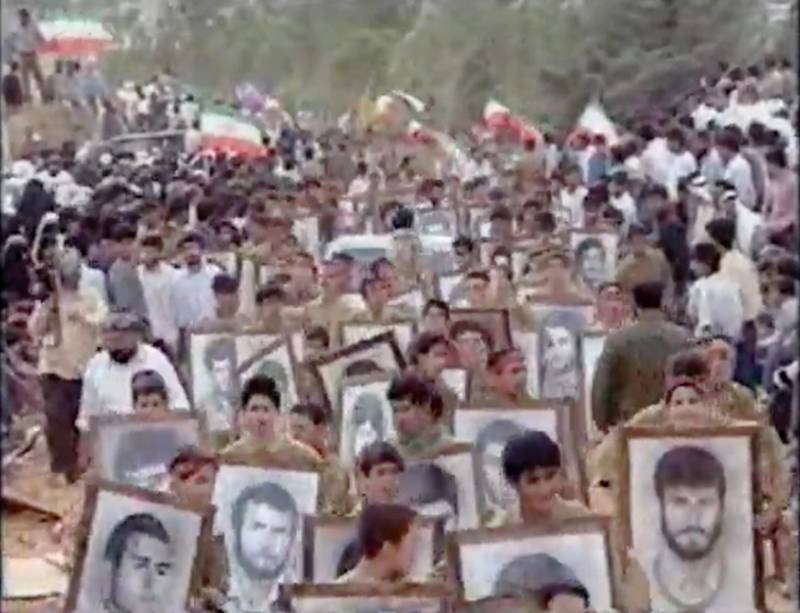

Film still from Alaa Mansour’s Aïnata, 2018
The man expresses a nostalgia for the secular Arab revolutionary idealism of the 70s and 80s, critiquing the resistance in Lebanon for its politicised religiosity. He says the resistance freed the soil, but failed to free the individual, decrying a culture privileging “bigoted rituals and lifeless bleak slogans” over reason. Mansour’s voice echoes this critique, saying “religious doctrine toppled the revolutionary passion […], they replaced memory with gardens full of idols and corpses”. Mansour says these lines over videos of a cortege with framed images of martyrs held aloft, and clips of fighters in headbands bearing political insignia. The narrators’ comments are more than a critique of politics, but serve as a questioning of form and how political imagery shapes memory. The rituals and slogans, the gardens of idols, usurp lived memories or individual reasoning, flattening interior worlds into rhetorical devices serving hegemonic narratives.
The film challenges these limitations of the image through its distortion and abstraction of its archival material. A warped recording of the Israeli national anthem plays as we see Israeli soldiers preparing warplanes for attack. The sound of their voices buzzes, recalling the constant hum of Israeli drones haunting Gaza’s sky continuously for the last two years. Footage of cracked stone in the Aïnata landscape is at one point so zoomed in and blurred you can scarcely make out what you’re seeing. Images of fighters are overlaid with videos of protests, collapsing the two media into one. TV clips loop, repeat, or change saturation.
This glitching resists the rigid nature of the image, refusing to distill memory into a legible and instrumentalised representation. Instead, the film evokes the true disorienting nature of memory under violence; certain images replay, others fade beyond recognition, some blend into one. Not only does the film reflect this fickleness of memory, but it represents the only way one can engage with a reality so ruptured, almost surreal in its cruelty. When our world and histories feel so distorted, what other form could their representation take?
It makes me think of the work of Muqata’a, Palestinian hip-hop and experimental electronic musician. Muqata’a’s production is sample-heavy, filled with field recordings, sounds from his parents’ cassette tape collection, recordings of live radio, or rips of old YouTube videos. These samples are then looped, and abstracted through jungle and trip-hop beats. This interpolation serves as a reclamation of a vulnerable heritage, but its subsequent glitching reflects the violence of its theft and the fractured reality in which it exists. Like Muqata’a, Mansour recognises the surreal and ruptured nature of our histories, and distorts archival media as the only honest and accurate mode of its representation.
Mansour carries out interviews with residents of Aïnata. She interviews an old man sitting outside his 100-year-old home, and asks him about his memories of the house. He recounts how the house used to have arches, before they were destroyed by the Israelis in 1978. They were soon rebuilt, only to be destroyed again by the Israeli-backed South Lebanon Army under Antoine Lahad. He goes on to lament Aïnata’s suffering, and speaks of collaborators and political violence. Mansour insists: “But how was it before Lahad and the Israeli occupation?”. He said they lived a peaceful life, with some young people heading to Palestine to fight the British, before he begins to mourn the theft of Palestine.
We see how war and colonial violence become the forefront of memory, diminishing what came before. The man’s recollections briefly flicker back to a hopeful time of youthful resistance, before collapsing back into mourning. Other interviews echo this, remembering past joys in light of current pains. One woman remembers how people used to help each other, gather to bake bread, and truly love one another. Another recounts her time living in Kuwait, how she hated being indoors there and longed for Aïnata where she was always outside. This moment could have offered a chance for an exploration of space, exile, or belonging, but instead the interview ends quickly. There are other moments like this, where the viewer is frustrated by what feels like unfinished conversations, or a missed opportunity to draw out deeper reflections.
Mansour later interviews a keeper of a crumbling mansion. She asks him how it feels to be there, and he answers on the history of the building and the decline of true craftsmanship. He later shows shrapnel scattered around the house, leftovers from shelling in 2006. Again, here is an opportunity to meditate on loss, or the dissonance of being a keeper to a destroyed mansion, but the interview does not delve deeper. This sense of aimlessness in the film is exacerbated by many visual longueurs; several shots of winding roads that linger too long, footage that feels like B-roll.
However, this unfinished and oneiric nature of the interviews and footage may mirror the film’s broader refusal of narrative clarity. Aïnata unfolds in fragments, ambiguities, and distorted archives. The hesitation in the interviews, the lengthy gaze of the shots… Memory isn’t coherent, so why should its representation be?
This experimental approach is situated within a wider artistic context of Lebanese and Palestinian archival interpolation and manipulation. Palestinian artist Basma al-Sharif’s 2009 film We Began by Measuring Distance comes to mind. The experimental video is narrated by a man describing an anonymous group who measure distances to pass the time, counting the distance from Gaza to Jerusalem multiple times, as the number continues to change. The film weaves together footage of jellyfish and the natural world, devastating videos of violence in Palestine, and performances of two figures holding up a sheet, all while a distorted and unsettling Abdelhalim Hafez song plays in the background. The combination of these surreal audiovisual elements, absurd attempts at quantification, and footage of real colonially-imposed suffering hint to the limitations of images and data in adequately capturing experiences of violence. Attempting to quantify or convey experiences of occupation and colonisation feel absurd in light of the true magnitude of suffering.
Aïnata similarly uses abstraction to expose the inadequacy of attempting to represent memories of violence. Being subject to one of the last remaining settler-colonial projects in the world is almost unreal in its cruelty, the full scale of which imagery cannot totally capture. Distortion and fragmentation move beyond purely aesthetic choices, and into necessary methods for Lebanese and Palestinian artists confronting the absurd violence of their histories.
A Lebanese archival project that is in conversation with the ideas explored in Aïnata is The Atlas Group, a project by Walid Raad between 1989 and 2004. The Atlas Group is a fictional foundation, researching and documenting Lebanon’s contemporary history, with a focus on the Lebanese Civil War. The organisation researches and documents audiovisual and literary materials on specific events or individuals related to the Civil War, with the artworks produced being a combination of found archives and fabricated documents. The fictional documents presented as true material history rupture the idea of the archive itself, and call into question its value as a historical record.
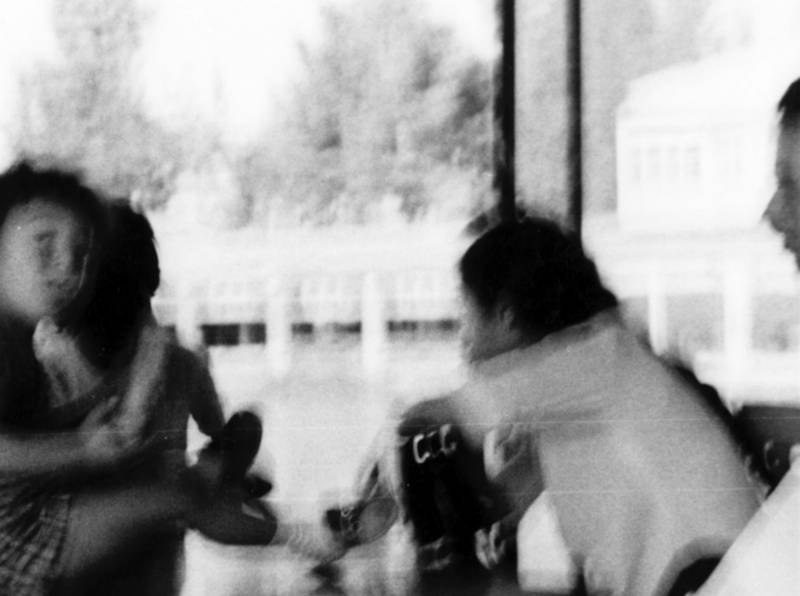

Film still from Alaa Mansour’s Aïnata, 2018
In a 2004 interview on the project, Raad says that people’s experiences of events are composed of unconscious feelings and traces which traditional documentation cannot fully capture. Drawing on Freud’s analysis of hysteria, Raad notes that when a subject undergoes a traumatic event, their memory of the event becomes supplanted by a fantasy. These fantasies are referred to as hysterical symptoms, bearing little resemblance to the original event but still carrying deep personal meaning. “The hysterical symptom then becomes, in a way, a document […]”, Raad says, “It’s a question of the production of a narrative that rings true to the subject”.
This is the summation of the logic of Aïnata. The “hysterical symptom”, the glitch, the distorted archive, become documents of their own right. Functioning as an anti-documentary, the film does not aim to reconstruct a linear chronology or clear image, but instead mirrors the psychopolitical dissonance left behind by war and occupation. This incohesive and disorienting narrative rings more true to the memories of the subject than any formal archival presentation could.
In a time of genocide, where cemeteries, historical monuments, and physical archives are bombed and destroyed, where images are weaponised and their meaning distorted, Aïnata’s meditations on memory are as pertinent as ever. In light of material destruction of histories, the film shows memories as they exist today: haunted, unresolved, and deeply fractured. I am hesitant to invoke the overused idea of “reclamation”, the idea that manipulating and interpolating archives is a form of resistance to their theft and erasure. Our current times have shown us the limits of our artistic and conceptual gestures; the war machine rages on, indifferent to our desperate attempts at creating meaning from destruction. We struggle to act, so the least we can do is speak truthfully, and honour the infinite magnitude of experience that lies beyond the image and the archive.
A note from Alaa Mansour
The words that follow are for clarification only. I am from the south of Lebanon, from Aïnata, where my parents were born, and which was under zionist occupation for nearly 25 years. I was raised alongside the Resistance and the faces of the martyrs, by a rebellious mother and a Marxist father who dreams of the liberation of humanity from colonial–capitalist servitude. I was, and still am, deeply influenced by my parents’ upbringing, which taught me that identity is a perpetual becoming, that we belong to the universe, that our fight in life is for truth and the collective, and that there is no distinction between freedom and responsibility.
This posture demands that we embrace critical thinking as a necessary path to question and understand reality in all its political, cultural, social, and metaphysical components and complexities. It is from this viewpoint that Aïnata, the film, was conceived and produced. I paved the way to Aïnata through the image of my home, bombarded to ashes on TV during the zionist war on Lebanon in 2006. I was 22 years old when I began to work on the film, obsessed with the future of a memory that has never found rest—a memory that ceaselessly rebirths and reimagines itself.
Alongside this, I was researching sacred violence and the commodification of death in relation to martyrdom and capitalism. This was integral to the film, which invites the viewer to critically examine the ‘failures’ of the resistance movements, whether Palestinian or Lebanese, and their ability—or inability—to fulfil the people’s dream of total liberation. I wanted to stress this point so that my motivations in addressing certain issues in Aïnata would be clear, and so that my discourse would be understood not as a critique of the Resistance as such, but of certain paradigms specific to a given historical and political time and space.
